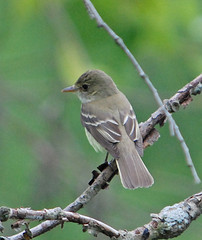Snowflake – It isn’t too far of a stretch to picture a flock of Snow Buntings over a snowy field and think “snowflakes”. In fact, at the turn of the century this is how Snow Buntings were referred to. When I was first reading through results of the 1906 Christmas Bird Count, I thought the reference to “about a dozen” snowflakes as some kind of old-fashioned birding joke, but in fact, this was an accurate report, given the lingo of the time.
Traill’s Flycatcher – Some of the more exciting name-changing events for birders are when species are split, and one name becomes two. Named after Thomas Stewart Traill, a Scottish professor of medical jurisprudence and promoter of zoology and natural history in the early 1800’s, this nondescript gray-and-white bird became two in 1973. Now known as either Willow or Alder Flycathers, the two species are nearly indistinguishable by sight, but have different songs and habitat preferences. Sometimes, when birders see one of the pair but don’t hear their song, a bird will still be given the ambiguous label of “Traill’s”.
Sparrow Hawk – … is neither a sparrow nor a hawk, so some explanation is warranted! This out-of-date term was used to refer to the American Kestrel, who’s diminutive size derived the “sparrow” part of its name. But the “hawk” part just didn’t fit, as kestrels are a type of falcon, not hawk, and so the name was officially changed in 1973. Many raptors names have similar delineation, and terms such as Fish Hawk, Pigeon Hawk, Marsh Hawk, Duck Hawk, and others still surface from time to time.
Bullbat – Birds that spend much of their lives near people tend to collect a plethora of pseudonyms, and so it is not surprising that a bird that nests on rooftops would be given a nickname. Even the official name “Common Nighthawk” is a bit of a misnomer, as these birds are neither hawks nor are they strictly nocturnal. Others may know the Common Nighthawk better as a “bullbat”, which is a more fitting term. The birds are erratic and bat-like in flight, and cruise over city streets at dusk, feeding on insects. But anyone who has seen a Nighthawk display during the breeding season knows why they call them "bull". Nighthawks will dive bomb other creatures that wander too close, including people, complimenting their bat-like flight with the attitude of a bull.





One constructed of stainless steel bird cage is heavier than the average bird cage. In addition, the construction is heavy duty. As a result, it is substantial and long lasting. Its weight and stability mean that the cage itself will not be easily knocked over. The cage will not wear out easily and will out last several bird cages made of other material.
ReplyDeletebird cages are made in a host of different materials. They can be bought in stainless steel, brass, aluminium and wood. Stainless steel are a common choice because they are strong and tend to last longer
ReplyDeletewow, Its really intrusting and wounder full.I read and really impressed from your topic .It's related to the bird cage.I like and saved .Thanks for submission...
ReplyDeleteThank you because you have been willing to share information with us. we will always appreciate all you have done here because I know you are very concerned with our. bird aviary niagara falls
ReplyDelete